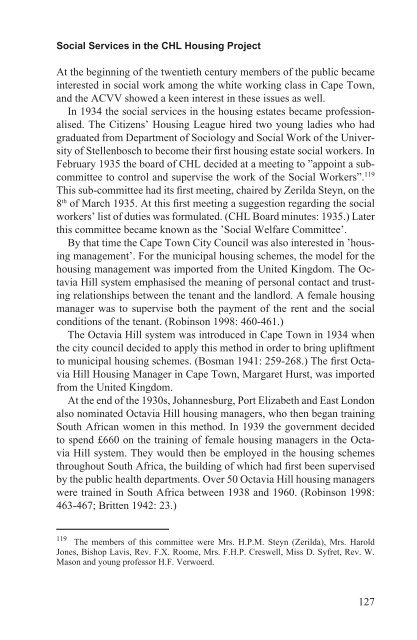The Making of a Good White - E-thesis - Helsinki.fi
The Making of a Good White - E-thesis - Helsinki.fi
The Making of a Good White - E-thesis - Helsinki.fi
You also want an ePaper? Increase the reach of your titles
YUMPU automatically turns print PDFs into web optimized ePapers that Google loves.
Social Services in the CHL Housing Project<br />
At the beginning <strong>of</strong> the twentieth century members <strong>of</strong> the public became<br />
interested in social work among the white working class in Cape Town,<br />
and the ACVV showed a keen interest in these issues as well.<br />
In 1934 the social services in the housing estates became pr<strong>of</strong>essionalised.<br />
<strong>The</strong> Citizens’ Housing League hired two young ladies who had<br />
graduated from Department <strong>of</strong> Sociology and Social Work <strong>of</strong> the University<br />
<strong>of</strong> Stellenbosch to become their <strong>fi</strong>rst housing estate social workers. In<br />
February 1935 the board <strong>of</strong> CHL decided at a meeting to ”appoint a subcommittee<br />
to control and supervise the work <strong>of</strong> the Social Workers”. 119<br />
This sub-committee had its <strong>fi</strong>rst meeting, chaired by Zerilda Steyn, on the<br />
8 th <strong>of</strong> March 1935. At this <strong>fi</strong>rst meeting a suggestion regarding the social<br />
workers’ list <strong>of</strong> duties was formulated. (CHL Board minutes: 1935.) Later<br />
this committee became known as the ’Social Welfare Committee’.<br />
By that time the Cape Town City Council was also interested in ’housing<br />
management’. For the municipal housing schemes, the model for the<br />
housing management was imported from the United Kingdom. <strong>The</strong> Octavia<br />
Hill system emphasised the meaning <strong>of</strong> personal contact and trusting<br />
relationships between the tenant and the landlord. A female housing<br />
manager was to supervise both the payment <strong>of</strong> the rent and the social<br />
conditions <strong>of</strong> the tenant. (Robinson 1998: 460-461.)<br />
<strong>The</strong> Octavia Hill system was introduced in Cape Town in 1934 when<br />
the city council decided to apply this method in order to bring upliftment<br />
to municipal housing schemes. (Bosman 1941: 259-268.) <strong>The</strong> <strong>fi</strong>rst Octavia<br />
Hill Housing Manager in Cape Town, Margaret Hurst, was imported<br />
from the United Kingdom.<br />
At the end <strong>of</strong> the 1930s, Johannesburg, Port Elizabeth and East London<br />
also nominated Octavia Hill housing managers, who then began training<br />
South African women in this method. In 1939 the government decided<br />
to spend £660 on the training <strong>of</strong> female housing managers in the Octavia<br />
Hill system. <strong>The</strong>y would then be employed in the housing schemes<br />
throughout South Africa, the building <strong>of</strong> which had <strong>fi</strong>rst been supervised<br />
by the public health departments. Over 50 Octavia Hill housing managers<br />
were trained in South Africa between 1938 and 1960. (Robinson 1998:<br />
463-467; Britten 1942: 23.)<br />
119<br />
<strong>The</strong> members <strong>of</strong> this committee were Mrs. H.P.M. Steyn (Zerilda), Mrs. Harold<br />
Jones, Bishop Lavis, Rev. F.X. Roome, Mrs. F.H.P. Creswell, Miss D. Syfret, Rev. W.<br />
Mason and young pr<strong>of</strong>essor H.F. Verwoerd.<br />
127
















